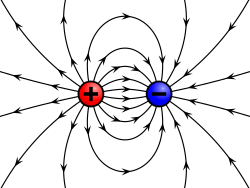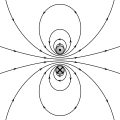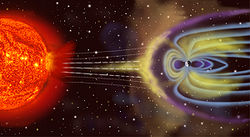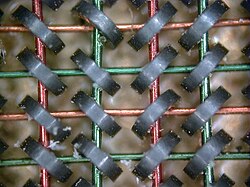Maxwell's equations
| Electromagnetism |
|---|
 |
| Electricity · Magnetism · Magnetic permeability |
Maxwell's equations describe how electric charges and electric currents create electric and magnetic fields. They describe how an electric field can generate a magnetic field.
In the 1860s James Clerk Maxwell published equations that describe how charged particles give rise to electric and magnetic force per unit charge. The force per unit charge is called a field. The particles could be stationary or moving. These, and the Lorentz force equation, give everything one needs to calculate the motion of classical particles in electric and magnetic fields.
The first equation allows one to calculate the electric field created by a charge. The second allows one to calculate the magnetic field. The other two describe how fields 'circulate' around their sources. Magnetic fields 'circulate' around electric currents and time varying electric fields: Ampère's law with Maxwell's extension, while electric fields 'circulate' around time varying magnetic fields: Faraday's law.
Maxwell's Equations in the classical forms
| Name | Differential form | Integral form |
|---|---|---|
| Gauss' law: | [math]\displaystyle{ \nabla \cdot \mathbf{D} = \rho }[/math] | [math]\displaystyle{ \oint_S \mathbf{D} \cdot d\mathbf{A} = \int_V \rho \cdot dV }[/math] |
| Gauss' law for magnetism (absence of magnetic monopoles): |
[math]\displaystyle{ \nabla \cdot \mathbf{B} = 0 }[/math] | [math]\displaystyle{ \oint_S \mathbf{B} \cdot d\mathbf{A} = 0 }[/math] |
| Faraday's law of induction: | [math]\displaystyle{ \nabla \times \mathbf{E} = -\frac{\partial \mathbf{B}} {\partial t} }[/math] | [math]\displaystyle{ \oint_C \mathbf{E} \cdot d\mathbf{l} - \oint_C \mathbf {B} \times \mathbf{v} \cdot d{\mathbf {l}} = - \ { d \over dt } \int_S \mathbf{B} \cdot d\mathbf{A} }[/math] |
| Ampère's law (with Maxwell's extension): |
[math]\displaystyle{ \nabla \times \mathbf{H} = \mathbf{J} + \frac{\partial \mathbf{D}} {\partial t} }[/math] | [math]\displaystyle{ \oint_C \mathbf{H} \cdot d\mathbf{l} = \int_S \mathbf{J} \cdot d \mathbf{A} + \int_S\frac{\partial \mathbf{D} }{\partial t}\cdot d \mathbf{A} }[/math] |
where the following table provides the meaning of each symbol and the SI unit of measure:
| Symbol | Meaning | SI Unit of Measure |
|---|---|---|
| [math]\displaystyle{ \mathbf{E} }[/math] | electric field | volt per metre |
| [math]\displaystyle{ \mathbf{H} }[/math] | magnetic field strength | ampere per metre |
| [math]\displaystyle{ \mathbf{D} }[/math] | electric displacement field | coulomb per square metre |
| [math]\displaystyle{ \mathbf{B} }[/math] | magnetic flux density also called the magnetic induction. |
tesla, or equivalently, weber per square metre |
| [math]\displaystyle{ \ \rho \ }[/math] | free electric charge density, not counting the dipole charges bound in a material. |
coulomb per cubic metre |
| [math]\displaystyle{ \mathbf{J} }[/math] | free current density, not counting polarization or magnetization currents bound in a material. |
ampere per square metre |
| [math]\displaystyle{ d\mathbf{A} }[/math] | differential vector element of surface area A, with very small magnitude and direction normal to surface S |
square meters |
| [math]\displaystyle{ dV \ }[/math] | differential element of volume V enclosed by surface S | cubic meters |
| [math]\displaystyle{ d \mathbf{l} }[/math] | differential vector element of path length tangential to contour C enclosing surface c | meters |
| [math]\displaystyle{ \mathbf{v} }[/math] | instantaneous velocity of the line element [math]\displaystyle{ d\mathbf{l} }[/math] defined above (for moving circuits). | meters per second |
and
- [math]\displaystyle{ \nabla \cdot }[/math] is the divergence operator (SI unit: 1 per metre),
- [math]\displaystyle{ \nabla \times }[/math] is the curl operator (SI unit: 1 per metre).
The meaning of the equations
Charge density and the electric field
- [math]\displaystyle{ \nabla \cdot \mathbf{D} = \rho }[/math],
where [math]\displaystyle{ {\rho} }[/math] is the free electric charge density (in units of C/m3), not counting the dipole charges bound in a material, and [math]\displaystyle{ \mathbf{D} }[/math] is the electric displacement field (in units of C/m2). This equation is like Coulomb's law for non-moving charges in vacuum.
The next integral form (by the divergence theorem), also known as Gauss' law, says the same thing:
- [math]\displaystyle{ \oint_A \mathbf{D} \cdot d\mathbf{A} = Q_\text{enclosed} }[/math]
[math]\displaystyle{ d\mathbf{A} }[/math] is the area of a differential square on the closed surface A. The surface normal pointing out is the direction, and [math]\displaystyle{ Q_\text{enclosed} }[/math] is the free charge that is inside the surface.
In a linear material, [math]\displaystyle{ \mathbf{D} }[/math] is directly related to the electric field [math]\displaystyle{ \mathbf{E} }[/math] with a constant called the permittivity, [math]\displaystyle{ \varepsilon }[/math] (This constant is different for different materials):
- [math]\displaystyle{ \mathbf{D} = \varepsilon \mathbf{E} }[/math].
You can pretend a material is linear, if the electric field is not very strong.
The permittivity of free space is called [math]\displaystyle{ \varepsilon_0 }[/math], and is used in this equation:
- [math]\displaystyle{ \nabla \cdot \mathbf{E} = \frac{\rho_t}{\varepsilon_0} }[/math]
Here [math]\displaystyle{ \mathbf{E} }[/math] is the electric field again (in units of V/m), [math]\displaystyle{ \rho_t }[/math] is the total charge density (including the bound charges), and [math]\displaystyle{ \varepsilon_0 }[/math] (approximately 8.854 pF/m) is the permittivity of free space. One can also write [math]\displaystyle{ \varepsilon }[/math] as [math]\displaystyle{ \varepsilon_0 \cdot \varepsilon_r }[/math]. Here, [math]\displaystyle{ \varepsilon_r }[/math] is the permittivity of the material when compared to the permittivity of free space. This is called the relative permittivity or dielectric constant.
See also Poisson's equation.
The structure of the magnetic field
- [math]\displaystyle{ \nabla \cdot \mathbf{B} = 0 }[/math]
[math]\displaystyle{ \mathbf{B} }[/math] is the magnetic flux density (in units of tesla, T), also called the magnetic induction.
This next integral form says the same thing:
- [math]\displaystyle{ \oint_A \mathbf{B} \cdot d\mathbf{A} = 0 }[/math]
The area of [math]\displaystyle{ d\mathbf{A} }[/math] is the area of a differential square on the surface [math]\displaystyle{ A }[/math]. The direction of [math]\displaystyle{ d\mathbf{A} }[/math] is the surface normal pointing outwards on the surface of [math]\displaystyle{ A }[/math].
This equation only works if the integral is done over a closed surface. This equation says, that in every volume the sum of the magnetic field lines that go in equals the sum of the magnetical field lines that go out. This means that the magnetic field lines must be closed loops. Another way of saying this is that the field lines cannot start from somewhere. This is the mathematical way of saying: "There are no magnetic monopoles".
A changing magnetic flux and the electric field
- [math]\displaystyle{ \nabla \times \mathbf{E} = -\frac {\partial \mathbf{B}}{\partial t} }[/math]
This next integral form says the same thing:
- [math]\displaystyle{ \oint_{s} \mathbf{E} \cdot d\mathbf{s} = - \frac {d\Phi_{\mathbf{B}}} {dt} }[/math]
Here [math]\displaystyle{ \Phi_{\mathbf{B}} = \int_{A} \mathbf{B} \cdot d\mathbf{A} }[/math]
This is what the symbols mean:
ΦB is the magnetic flux that goes through the area A that the second equation describes,
E is the electric field that the magnetic flux causes,
s is a closed path in which current is induced, for example a wire,
v is the instantaneous velocity of the line element (for moving circuits).
The electromotive force is equal to the value of this integral. Sometimes this symbol is used for the electromotive force: [math]\displaystyle{ \mathcal{E} }[/math], do not confuse it with the symbol for permittivity that was used before.
This law is like Faraday's law of electromagnetic induction.
Some textbooks show the right hand sign of the integral form with an N (N is the number of coils of wire that are around the edge of A) in front of the flux derivative. The N can be taken care of in calculating A (multiple wire coils means multiple surfaces for the flux to go through), and it is an engineering detail so it's left out here.
The negative sign is needed for conservation of energy. It is so important that it even has its own name, Lenz's law.
This equation shows how the electric and magnetic fields have to do with each other. For example, this equation explains how electric motors and electric generators work. In a motor or generator, the field circuit has a fixed electric field that causes a magnetic field. This is called fixed excitation. The varying voltage is measured across the armature circuit. Maxwell's equations are used in a right-handed coordinate system. To use them in a left-handed system, without having to change the equations, the polarity of magnetic fields has to be made opposite (this is not wrong, but it is confusing because it is not usually done like this).
The source of the magnetic field
- [math]\displaystyle{ \nabla \times \mathbf{H} = \mathbf{J} + \frac {\partial \mathbf{D}} {\partial t} }[/math]
H is the magnetic field strength (in units of A/m), which you can get by dividing the magnetic flux B by a constant called the permeability, μ (B = μH), and J is the current density, defined by:
J = ∫ρqvdA
v is a vector field called the drift velocity. It describes the speeds of the charge carriers that have a density described by the scalar function ρq.
In free space, the permeability μ is the permeability of free space, μ0, which is exactly 4π×10−7 W/A·m, by definition. Also, the permittivity is the permittivity of free space ε0. So, in free space, the equation is:
- [math]\displaystyle{ \nabla \times \mathbf{B} = \mu_0 \mathbf{J} + \mu_0\varepsilon_0 \frac{\partial \mathbf{E}}{\partial t} }[/math]
The next integral form says the same thing:
- [math]\displaystyle{ \oint_s \mathbf{B} \cdot d\mathbf{s} = \mu_0 I_\text{encircled} + \mu_0\varepsilon_0 \int_A \frac{\partial \mathbf{E}}{\partial t} \cdot d \mathbf{A} }[/math]
s is the edge of the open surface A (any surface with the curve s as its edge is okay here), and Iencircled is the current encircled by the curve s (the current through any surface is defined by the equation: Ithrough A = ∫AJ·dA).
If the electric flux density does not change very fast, the second term on the right hand side (the displacement flux) is very small and can be left out, and then the equation is the same as Ampere's law.
Covariant Formulation
There are only two covariant Maxwell Equations, because the covariant field vector includes the electrical and the magnetical field.
Mathematical note: In this section the abstract index notation will be used.
In special relativity, Maxwell's equations for the vacuum are written in terms of four-vectors and tensors in the "manifestly covariant" form. This has been done to show more clearly the fact that Maxwell's equations (in vacuum) take the same form in any inertial coordinate system. This is the "manifestly covariant" form:
- [math]\displaystyle{ J^ b = \partial_a F^{ab} \,\! }[/math],
and
- [math]\displaystyle{ 0 = \partial_c F_{ab} + \partial_b F_{ca} + \partial_a F_{bc} }[/math]
The second equation is the same as:
- [math]\displaystyle{ 0 = \varepsilon_{dabc}\partial^a F^{bc} \,\! }[/math]
Here [math]\displaystyle{ \, J^a }[/math] is the 4-current, [math]\displaystyle{ \, F^{ab} }[/math] is the field strength tensor (written as a 4 × 4 matrix), [math]\displaystyle{ \, \varepsilon_{abcd} }[/math] is the Levi-Civita symbol, and [math]\displaystyle{ \partial_a = (\partial/\partial ct, \nabla) }[/math] is the 4-gradient (so that [math]\displaystyle{ \partial_a \partial^a }[/math] is the d'Alembertian operator). (The [math]\displaystyle{ a }[/math] in the first equation is implicitly summed over, according to Einstein notation.) The first tensor equation says the same thing as the two inhomogeneous Maxwell's equations: Gauss' law and Ampere's law with Maxwell's correction. The second equation say the same thing as the other two equations, the homogeneous equations: Faraday's law of induction and the absence of magnetic monopoles.
[math]\displaystyle{ \, J^a }[/math] can also be described more explicitly by this equation: [math]\displaystyle{ J^a = \, (c \rho, \vec J) }[/math] (as a contravariant vector), where you get [math]\displaystyle{ \, J^a }[/math] from the charge density ρ and the current density [math]\displaystyle{ \vec J }[/math]. The 4-current is a solution to the continuity equation:
[math]\displaystyle{ J^a{}_{,a} \, = 0 }[/math]
In terms of the 4-potential (as a contravariant vector) [math]\displaystyle{ A^{a} = \left(\phi, \vec A c \right) }[/math], where φ is the electric potential and [math]\displaystyle{ \vec A }[/math] is the magnetic vector potential in the Lorentz gauge [math]\displaystyle{ \left ( \partial_a A^a = 0 \right ) }[/math], F can be written as:
- [math]\displaystyle{ F^{ab} = \partial^b A^a - \partial^a A^b \,\! }[/math]
which leads to the 4 × 4 matrix rank-2 tensor:
- [math]\displaystyle{ F^{ab} = \left( \begin{matrix} 0 & -\frac {E_x}{c} & -\frac {E_y}{c} & -\frac {E_z}{c} \\ \frac{E_x}{c} & 0 & -B_z & B_y \\ \frac{E_y}{c} & B_z & 0 & -B_x \\ \frac{E_z}{c} & -B_y & B_x & 0 \end{matrix} \right) . }[/math]
The fact that both electric and magnetic fields are combined into a single tensor shows the fact that, according to relativity, both of these are different parts of the same thing—by changing frames of reference, what looks like an electric field in one frame can look like a magnetic field in another frame, and the other way around.
Using the tensor form of Maxwell's equations, the first equation implies
[math]\displaystyle{ \Box F^{ab} = 0 }[/math] (See Electromagnetic four-potential for the relationship between the d'Alembertian of the four-potential and the four-current, expressed in terms of the older vector operator notation).
Different authors sometimes use different sign conventions for these tensors and 4-vectors (but this does not change what they mean).
[math]\displaystyle{ \, F^{ab} }[/math] and [math]\displaystyle{ \, F_{ab} }[/math] are not the same: they are related by the Minkowski metric tensor [math]\displaystyle{ \eta }[/math]: [math]\displaystyle{ F_{ab} =\, \eta_{ac} \eta_{bd} F^{cd} }[/math]. This changes the sign of some of F's components; more complex metric dualities can be seen in general relativity.
Other websites
- Maxwell equations - Citizendium
Maxwell's Equations Media
Gauss's law for magnetism: magnetic field lines never begin nor end but form loops or extend to infinity as shown here with the magnetic field due to a ring of current.
In a geomagnetic storm, solar wind plasma impacts Earth's magnetic field causing a time-dependent change in the field, thus inducing electric fields in Earth's atmosphere and conductive lithosphere which can destabilize power grids. (Not to scale.)
Magnetic-core memory (1954) is an application of Ampère's circuital law. Each core stores one bit of data.
Volume Ω and its closed boundary ∂Ω, containing (respectively enclosing) a source (+) and sink (−) of a vector field F. Here, F could be the E field with source electric charges, but not the B field, which has no magnetic charges as shown. The outward unit normal is n.
Surface Σ with closed boundary ∂Σ. F could be the E or B fields. Again, n is the unit normal. (The curl of a vector field does not literally look like the "circulations", this is a heuristic depiction.)
Left: A schematic view of how an assembly of microscopic dipoles produces opposite surface charges as shown at top and bottom. Right: How an assembly of microscopic current loops add together to produce a macroscopically circulating current loop. Inside the boundaries, the individual contributions tend to cancel, but at the boundaries no cancelation occurs.







